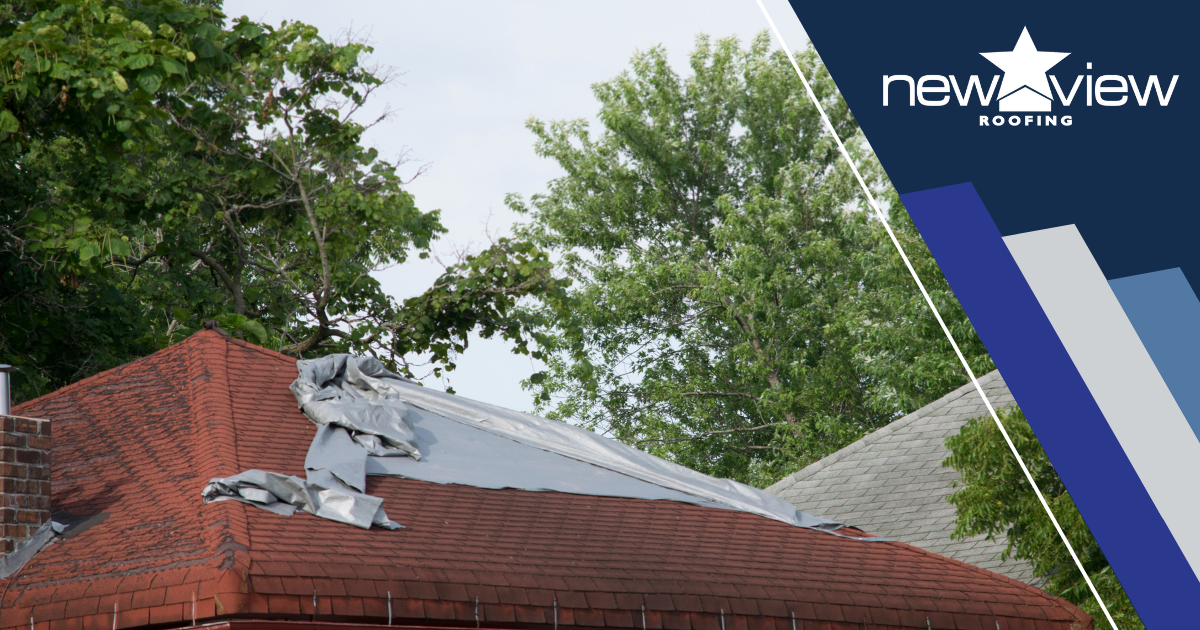If your roof needs emergency repairs because it’s been damaged, it’s leaking or it’s collapsed, you need to act quickly. In fact, the sooner you act, the better off you’ll be. But what are you supposed to do when you need emergency roof repair? This guide explains the five steps you need to take.
5 Things to Do When You Need Emergency Roof Repair

Whether you’ve noticed a leak or another type of roof damage, these are the five things you need to do:
- Call a roofing contractor
- Get in touch with your insurance company
- Remove your belongings
- Cover what you can’t take out
- Get to a safe location
Here’s a closer look at each.
Emergency Roof Repair Action #1: Call a Roofing Contractor
When you notice a leak or any other type of roof damage, your first call should be to a roofing contractor you can trust. You need someone to come prevent further damage and make repairs as quickly as possible, which means you need a roofing company that’s always on-call.
New View Roofing provides emergency roof repairs, and we can get to you quickly. Our team knows exactly what to do to stop leaks, protect your home or business, and ensure that your roof is fixed so you don’t experience further issues.
Related: Signs your roof is failing
Emergency Roof Repair Action #2: Get in Touch With Your Insurance Company
Your insurance company will need to know about the damage your home or business has sustained. In many cases, insurance covers repairs you need to make due to natural causes. For example, if a huge storm blows through and takes some tiles or shingles off your roof, there’s a chance that your insurance company will pay for the necessary repairs.
You should call your insurance company right after you call a roof repair company. That way, you can get out there and take photos that you’ll likely need to submit when you make a claim. Additionally, if the insurance company needs to send someone to evaluate the damage, they can do so at the same time as your roof repair contractor.
Emergency Roof Repair Action #3: Remove Your Belongings
If it’s safe for you to do so, move anything that could be damaged as a result of the issues with your roof. For example, if your ceiling is leaking above your sofa, move the sofa. It may also be a good idea to put a bucket or another container beneath the leak to prevent damage to your floors.
You should only remove your belongings if it’s safe to do so. If the roof appears in danger of collapsing, or if the leak is too severe and has already done significant damage to your belongings, it’s best to leave things where they are.
Related: How to get the most of an insurance claim for a damaged roof
Emergency Roof Repair Action #4: Cover What You Can’t Take Out
If you can’t remove items that are in danger of getting wet or being exposed to the elements, cover them. A large plastic tarp is ideal, but if you don’t have one, you can substitute trash bags or anything else you have handy. When our emergency roof repair team arrives, we’ll put a tarp over the damaged part of your roof to block out water, wind and other threats.
Warning: You shouldn’t attempt to put a tarp over your damaged roof unless you have experience in roofing. Climbing on a damaged roof — particularly in potentially hazardous conditions such as rain or ice — is dangerous. That’s something you should leave to the professionals at New View Roofing. Our team has the experience and safety equipment to get the job done.
Emergency Roof Repair Action #5: Get to a Safe Location
If your roof is in danger of collapsing, you need to leave and go to a safer location. You shouldn’t reenter your space until you’ve talked to a professional roofer.
Related: Roof maintenance saves you money in the long run – here’s why
How Do You Know When You Need Emergency Roof Repair?
 First, you need to know that a visible leak is an emergency. If your roof is leaking, it has the potential to become much worse very quickly. That means you need to call for emergency roof repairs right away.
First, you need to know that a visible leak is an emergency. If your roof is leaking, it has the potential to become much worse very quickly. That means you need to call for emergency roof repairs right away.
The sooner you can get a roofing contractor to find the source of the leak and patch it, the better off you’ll be. Patching the leak will prevent further damage and enable your roofer to determine how much work needs to be done to make repairs.
Remember, roof leaks never get better with time. They can become worse very quickly, and even a relatively small leak can lead to catastrophic damage. If you leave a roof leak untreated, it can lead to structural failure.
Other signs that you may need emergency roof repairs include:
- A sagging roof
- Visible daylight in your attic
- Mold or moisture growth in your attic
- Missing roofing materials
What a Sagging Roof Means
When a roof is poorly built, or when it’s exposed to more weight than it’s designed to bear, it can sag. Sagging means that the wood used for bracing or rafters and trusses is (or was) under serious strain, and it could collapse. Sometimes roofs sag when the shingles are too heavy, after big snowstorms (snow is heavy), or when they’re built improperly. Because a sagging roof could collapse, it means you need emergency roof repair.
What if You Can See Daylight in Your Attic?
If you can see daylight coming in through your attic, you need emergency roof repairs. Your attic should be completely sealed off (other than through the ventilation system) so daylight can’t get in. If daylight can get in, so can water — and so can a number of pests, too.
How Does an Attic Get Mold in It?
Attics are supposed to be dry spaces. The ventilation system your builder put in should be adequate to keep air flow moving — even in humid environments — and that should prevent moisture from building up. However, that’s not always the case; sometimes attics become damp, which creates the perfect breeding ground for mold spores.
Another way attics foster mold growth is through roof leaks. When your roof is leaking, water is introduced into the otherwise-dry environment. It can seep into your insulation, the wood that holds up your roof, or even the items you store in the attic.
Related: 7 questions to ask a professional roofer
What if You’re Missing Shingles, Nails, Flashing or Other Roofing Materials?
Every component of your roof, from the shingles to the nails that hold them in place, plays an important role in protecting your home or business. If shingles, nails, flashing (the material around chimneys, skylights, vents and other items that protrude from your roof) or other roofing materials are missing, your roof can’t protect your space like it should. Although it’s okay if one shingle is missing for a few minutes on a sunny, dry day, it’s something you need to address as quickly as possible to prevent further damage.
The Most Common Causes of Roof Damage
Your roof faces threats from every direction, but severe weather tops the list. Hailstorms can pummel roofing materials, high winds can rip shingles away, and continuous sun exposure can degrade your roof over time. Unpredictable events — like fires — can compromise the roof’s structure instantly. Regular inspections are your main line of defense because they allow you to identify and fix vulnerabilities before they get worse; that includes after major weather events and when you notice signs of interior damage, such as water stains on your ceilings or walls.
When is Roof Damage an Emergency?
Consider roof damage an emergency if it threatens your home’s structural integrity or your safety. Immediate action can prevent further harm and protect your living space.
Related: 10 questions to ask after a roof inspection
Should You Stay in a Home With a Damaged Roof?
Staying in a home with a damaged roof isn’t a good idea if the damage affects your safety. It’s best to arrange for a temporary safe place until professionals can get new materials in place.
Related: How to get your insurance company to pay for a new roof
Why Small Leaks Can Lead to Big Trouble
Even a small leak can cause significant problems over time. Addressing leaks quickly prevents more extensive damage and can save you from costly repairs in the future.
Water can corrode metal or cause rust, and it can cause wood to decay and rot. These types of damage compromise your home’s structural integrity. As building materials like drywall and insulation become saturated, they may swell, warp or break down, necessitating costly repairs.
Health Hazards and Home Safety
Leaks (and the dampness they cause) create an ideal environment for mold and mildew, which can lead to health issues — particularly for people with respiratory conditions.
Some of the health problems associated with mold exposure include:
- Allergic reactions: These are the most common health problems from mold and can include sneezing, runny nose, red eyes and skin rash (dermatitis). Mold allergies can also trigger asthma attacks in people who are allergic.
- Respiratory issues: Exposure to mold spores can lead to respiratory symptoms, including coughing, wheezing and difficulty breathing, even in people who are not allergic to mold.
- Irritation: Mold can irritate the eyes, skin, nose, throat and lungs, even in people who aren’t allergic to it. This can lead to a burning sensation, redness or discomfort.
- Infections: People with weakened immune systems can be susceptible to fungal infections from molds.
- Toxic effects: Some molds produce mycotoxins that can pose serious health risks to humans and animals. Exposure to high levels of mycotoxins can lead to neurological problems and in some cases, death. Prolonged exposure, such as what can occur in a home, can be particularly harmful.
- Asthma: For people with asthma, mold exposure can cause asthma attacks. In some cases, exposure to mold can also lead to the development of asthma in some children.
- Chronic sinusitis: There is some evidence to suggest that prolonged exposure to mold can lead to chronic sinusitis.
It’s important to note that the reaction to mold can vary greatly depending on the individual and the duration of exposure. Some people may not experience any symptoms at all, while others can be severely affected. If mold and mildew are present in a home, it’s important to remove the mold and correct the conditions that allow it to grow to prevent health problems.Top of Form
Additionally, water from leaks can reach electrical systems, posing a risk of short circuits and potential fires. Leaks can also provide entry points for pests, leading to infestations that are difficult to manage.
Financial Implications
 If the leak affects your home’s thermal envelope, it can cause heating and cooling systems to work harder, leading to higher energy costs. Over time, the expense of addressing the damage caused by a leak can far exceed the cost of an early fix.
If the leak affects your home’s thermal envelope, it can cause heating and cooling systems to work harder, leading to higher energy costs. Over time, the expense of addressing the damage caused by a leak can far exceed the cost of an early fix.
Aesthetic and Property Value Impact
Leaks can leave stains and cause damage that affects the appearance of your home. This not only requires additional maintenance but can also reduce the overall value of your property.
It’s important to address leaks promptly to prevent these potential problems. Regular maintenance and immediate action upon discovering a leak can save you from the far-reaching consequences you may have to face if you let it go for too long.
Related: What to do about storm damage to your roof
Do You Need to Talk to an Expert About Emergency Roof Repairs?
If you need to talk to an expert about emergency roof repairs, or if you need to schedule a free roof inspection to make sure your roof is still protecting your home or business the way it should, we’re here. Call our office today or schedule your free roof inspection online now — we’re always here to help.








